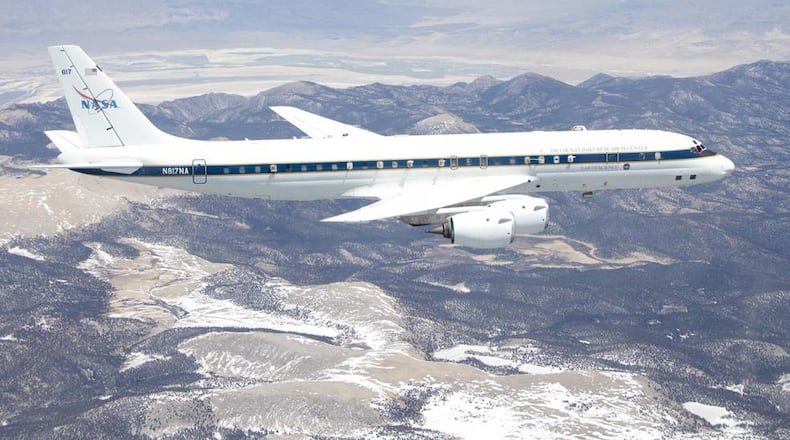The project involves not just detailed analysis of air quality, but a bit of challenging flying, conducting aerial research at altitudes as low as 1,000 feet above large cities and sometimes lower over the ocean — as low as 500 feet.
“It’s pretty much the perfect NASA aircraft that we need,” Gilman, a 1997 Vandalia-Butler High School graduate, told this news outlet in an interview Tuesday.
“The NASA pilots here are actually pretty amazing,” she added.
Spearheaded by the NOAA, the project has been dubbed the “Atmospheric Emissions and Reactions Observed from Megacities to Marine Areas” — or “AEROMMA.”
It’s an effort to gather data on pollution sources and levels, as more motorists come to rely on “cleaner” electric and fuel-efficient vehicles.
Operated by NASA’s Armstrong Flight Research Center, the DC-8 will fly from the end of June through mid-August, according to NOAA.
According to a NOAA web site on the project, the DC-8 will use either airports in either Dayton or Columbus to survey major urban areas on the east coast, such as New York.
An NOAA schedule online has the DC-8 focused on “urban Dayton” from July 25 to August 17.
But that doesn’t mean the project is studying Dayton-area air pollution, Gilman noted. Instead, the area will serve as a base of operations for research above big cities on the East coast and in the Midwest until mid-August.
The plane is slated to fly over New York City, Chicago, Detroit and Toronto.
“We’re interested in emissions from U.S. mega-cities and how those emissions are changing over time as cars become cleaner,” Gilman said.
The focus will be on how volatile chemical products like paints, solvents, coatings and more “are starting to dominate urban air pollution.”
“Less is known about them,” Gilman said of those non-vehicular pollution sources.
The idea is to compare emissions from cities, tracking them as they travel downstream, to “follow that urban plume,” seeing how emissions change in the atmosphere, leading to ozone and particle formation, she said.
Ozone and airborne particles can cause breathing problems, particularly for those suffering from asthma or COPD, as well as the elderly and the very young.
“Cars are still important” as a source of pollution, Gilman said. “It’s a different mixture of cars and VOCs (volatile organic compounds). It’s also different urban areas. In New York, there are quite a bit of trees, versus Chicago, (where) there’s quite a bit of agriculture. It’s how all of these different emission sources mix together and then chemically transform in the atmosphere.”
NOAA and NASA developed flight plans with the Federal Aviation Administration for the low-altitude flights above cities. The Gulfstream planes will fly at higher altitudes.
“It’s really tricky,” Gilman said with a laugh. “It requires a lot of forethought and planning.”
While the DC-8 will fly at safe altitudes for the public, wildlife, and infrastructure, a NASA media advisory is advising city residents that the four-engine plane is “very loud and those with sensitivity to loud noises should be aware of the flyover window.”
“Their goal is to study the air quality hovering over some of our most densely populated spaces in North America, including Los Angeles, Chicago, New York, and Toronto,” NASA said in a release earlier this month. “The DC-8 will conduct a series of low-altitude flights in order to investigate urban emissions and the atmospheric chemical reactions that affect air quality and climate. These emission sources include personal care products, cleaning agents, smaller gas burning devices, and landfills.”
About the Author



